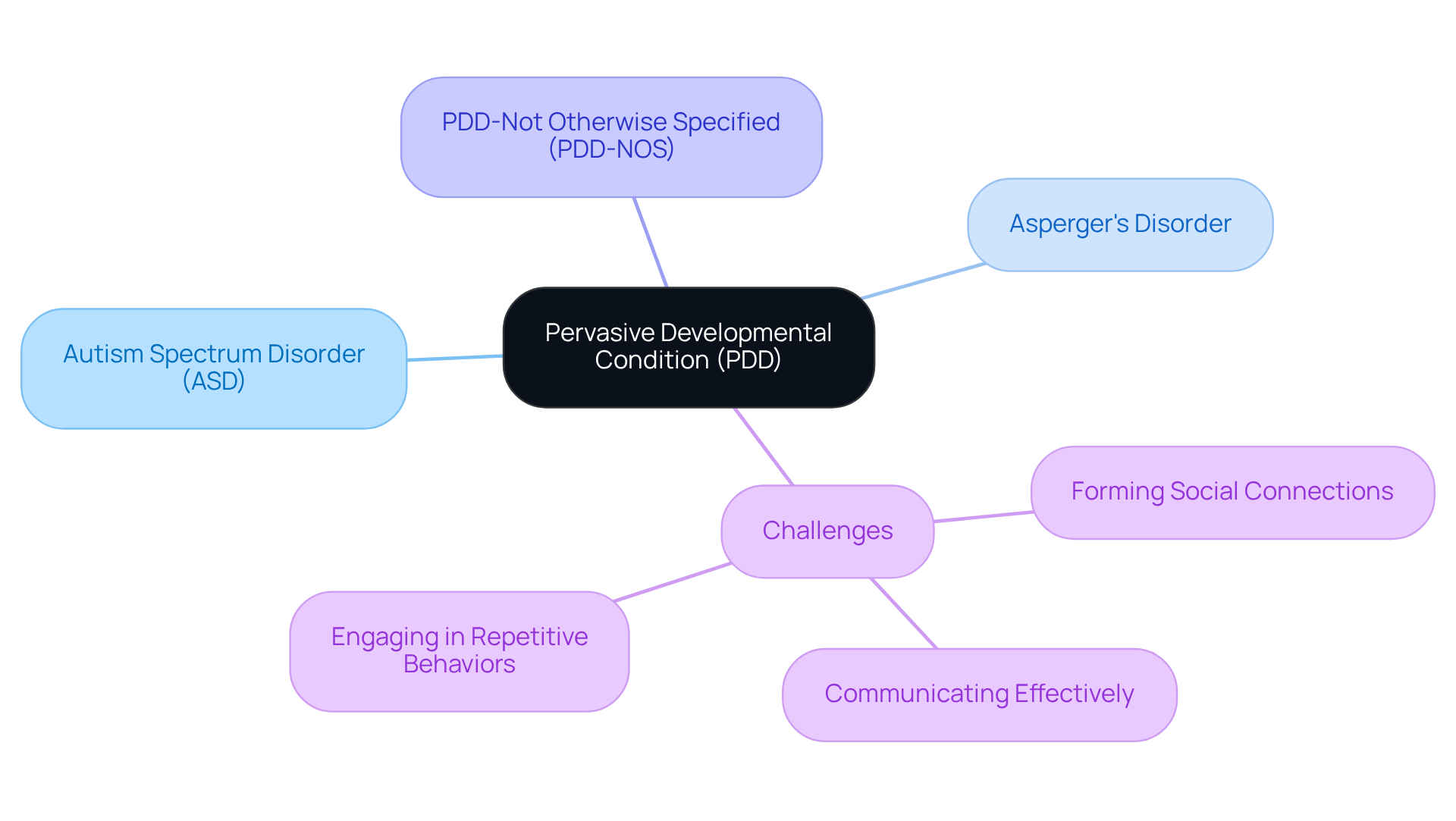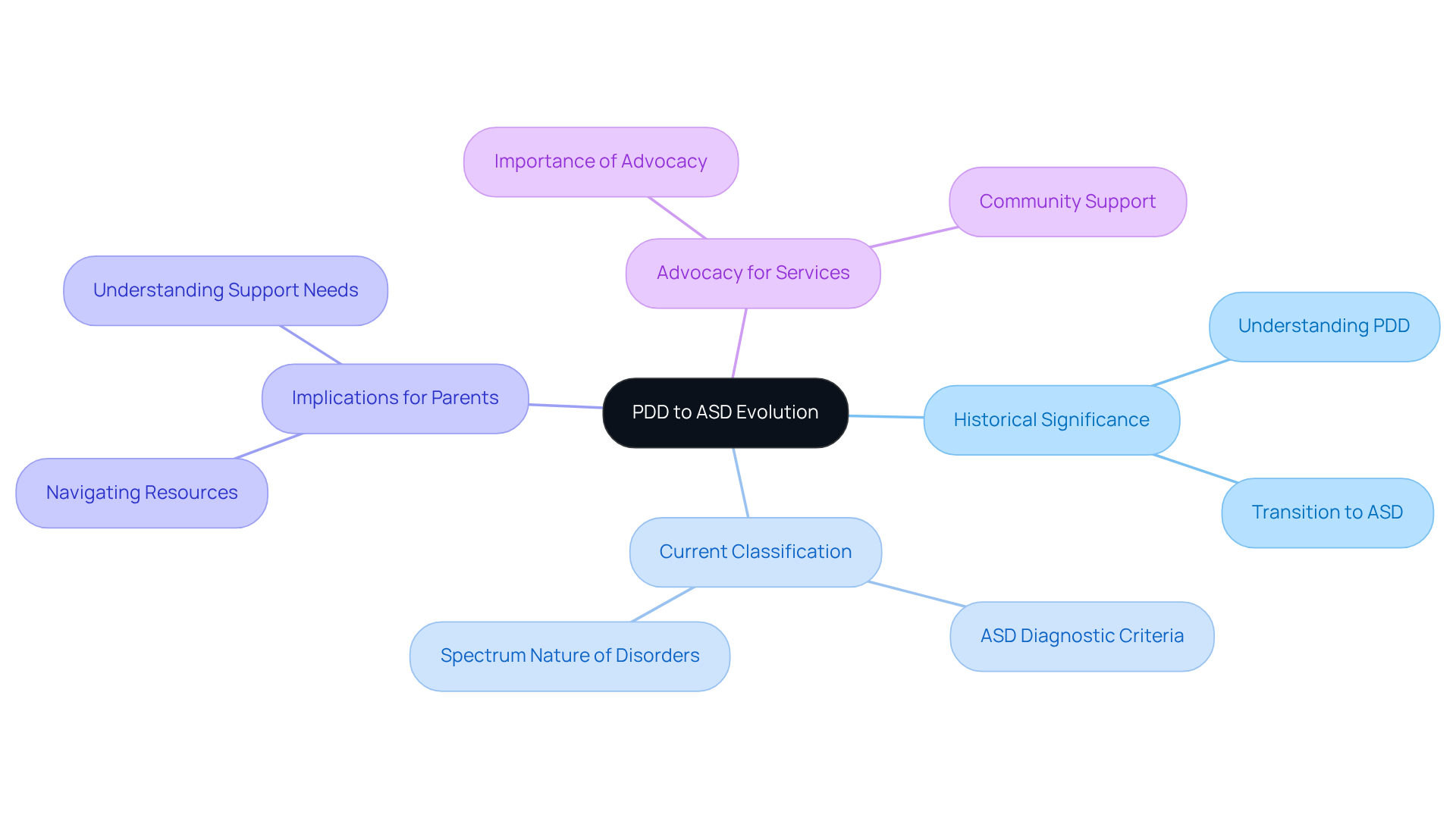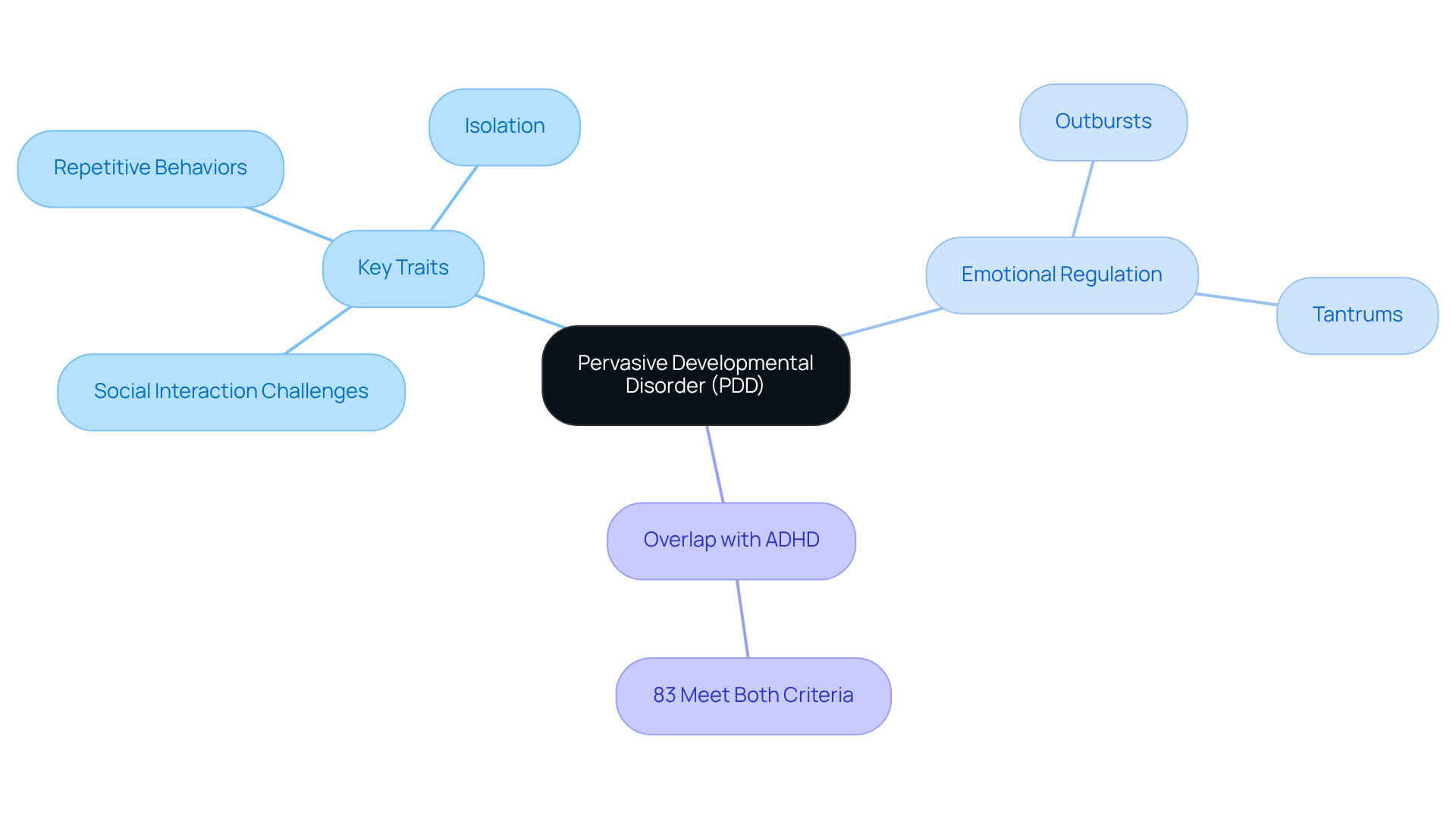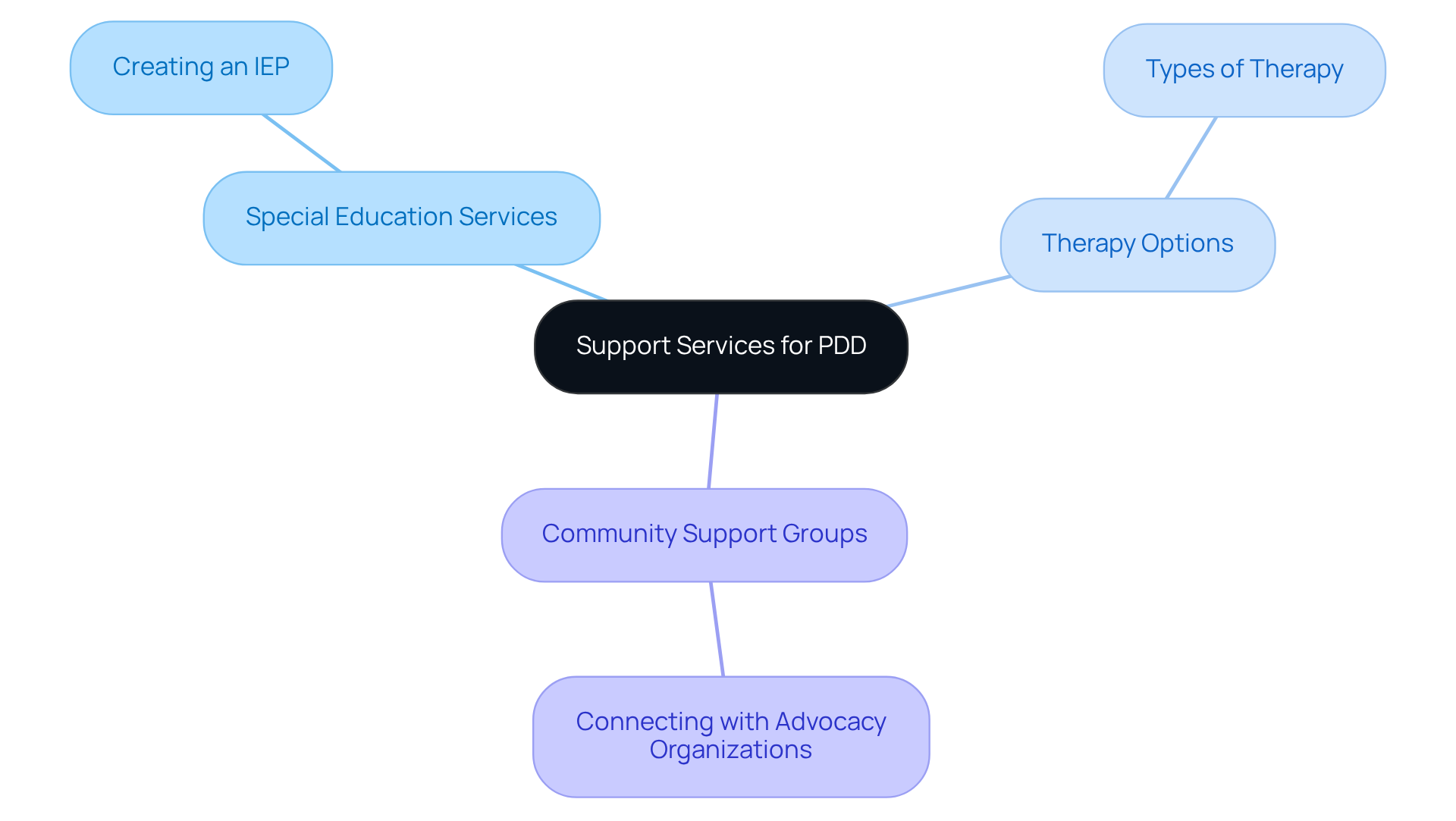Overview
In this article, we explore the vital definition of Pervasive Developmental Disorder (PDD) and its profound significance for parent advocates. PDD, classified among neurodevelopmental conditions such as Autism Spectrum Disorder (ASD), deserves our attention and understanding. By delving into PDD's characteristics and historical context, we can better appreciate the challenges faced by families and the importance of available support services. This knowledge empowers us to advocate effectively for children navigating these developmental hurdles, fostering a more informed and compassionate community.
Understanding PDD is not just about definitions; it’s about recognizing the emotional journey of families. Many parents feel overwhelmed, searching for clarity and guidance. By sharing experiences and resources, we can create a supportive network that nurtures understanding and hope. Let’s come together to ensure that every child with PDD receives the advocacy and support they deserve, transforming challenges into opportunities for growth and connection.
Introduction
Understanding Pervasive Developmental Disorder (PDD) is essential for parents and advocates as they navigate the complexities of neurodevelopmental conditions, such as Autism Spectrum Disorder. This article explores the definition, historical context, and key characteristics of PDD, providing insights designed to empower parents in their journey to support their children effectively.
As our understanding of these conditions evolves, it raises an important question: how can advocates ensure they are equipped with the right knowledge and resources to champion the needs of youth affected by PDD? Your role in this journey is vital, and together, we can make a difference.
Define PDD: Understanding the Basics
Pervasive Developmental Condition (PDD) encompasses a range of neurodevelopmental conditions that deeply impact social interaction, communication, and behavior. This category includes:
- Autism Spectrum Disorder (ASD)
- Asperger's Disorder
- PDD-Not Otherwise Specified (PDD-NOS)
While the term PDD may not be as commonly used today, understanding the definition of PDD is vital for parents and advocates navigating the complexities of autism-related conditions.
Typically, PDD manifests in early childhood, with symptoms often becoming noticeable by age three. Children with PDD may encounter challenges such as:
- Forming social connections
- Communicating effectively
- Engaging in repetitive behaviors
The increasing prevalence of PDD among youth has sparked concern, with recent statistics revealing a rise in diagnoses. This has led to important discussions about improving identification methods while also addressing the risk of potential overdiagnosis.
Supporters highlight the unique experiences of youth with PDD, as illustrated by Temple Grandin's poignant statement, 'I am different, not less.' Such quotes remind us of the importance of fostering understanding and acceptance within our communities. Recognizing the key features of the definition of PDD is essential for developing effective support strategies that empower children and their families. Together, we can create an environment where every child is understood and valued.

Contextualize PDD: Its Role in Autism Spectrum Disorders
The definition PDD once served as a primary classification for various developmental disorders. However, it has largely been integrated into the broader category of Autism Spectrum Disorder (ASD) in today's diagnostic criteria. This evolution from PDD to ASD reflects a deeper understanding of the spectrum nature of these disorders, where individuals can display a wide range of symptoms and severity.
As parents, it’s essential to recognize that while the definition PDD is no longer an official diagnosis, its historical significance remains vital in our discussions about developmental challenges. Many individuals who were previously diagnosed with PDD, as outlined in the definition PDD, now fall under the ASD classification, and understanding this transition can help us navigate the resources available for our children.
This comprehension is crucial for advocating suitable services and support for youth with developmental disorders. By acknowledging the past, we can better address the present needs of our children and ensure they receive the assistance they deserve. Let’s continue to share our experiences and support one another in this journey, fostering a community that uplifts and empowers.

Trace the Origin: Historical Development of PDD
The definition PDD, which stands for Pervasive Developmental Disorder, emerged in the late 20th century as clinicians began to recognize a spectrum of developmental challenges that didn’t fit neatly into existing diagnostic categories. Initially, the definition PDD referred to individuals who showed significant delays in social and communication abilities but did not meet the criteria for classic developmental disorders. Early estimates suggested that this disorder affected between 1 in 2,500 to 10,000 children, reflecting a limited understanding of the condition at that time.
As research progressed, our understanding of the definition PDD deepened, leading to significant changes in diagnostic criteria. The Diagnostic and Statistical Manual of Mental Disorders (DSM) has undergone several revisions, culminating in the DSM-5, which consolidated PDD into the broader category of Autism Spectrum Disorder (ASD). This change represents a more nuanced understanding of the complexities of the condition, acknowledging that it encompasses a range of symptoms and severity levels.
Historically, the evolution of terminology related to the condition has been shaped by societal perceptions and scientific advancements. For example, the DSM-II, published in 1968, described the disorder as a form of childhood schizophrenia, a misrepresentation that contributed to stigma. Notably, Leo Kanner described the condition as a 'profound emotional disturbance' that did not affect cognition, underscoring the need for a more precise definition PDD of the disorder. Over the decades, increased awareness and improved diagnostic tools have led to a significant rise in ASD diagnoses. Current estimates indicate that 1 in 36 children are now recognized as having the condition, an increase from 1 in 54 in 2016 according to the CDC.
The evolution of diagnostic criteria has not only enhanced the accuracy of autism diagnoses but also underscored the importance of tailored interventions. Researchers, including Eric Fombonne, emphasize that the recent upward trend in prevalence estimates cannot be directly attributed to an increase in incidence; rather, it reflects enhanced awareness and changes in diagnostic practices. This understanding is crucial for parents advocating for their children, as it highlights the need for appropriate support and resources that are customized to individual needs.
In navigating this journey, remember that you are not alone. Seeking support and sharing experiences can make a significant difference. Consider connecting with local support groups or online communities where you can find understanding and guidance tailored to your family’s unique situation.

Identify Key Characteristics: Traits and Symptoms of PDD
The definition PDD refers to Pervasive Developmental Disorder, which presents significant challenges in social interaction, communication, and often includes repetitive behaviors. For many children, the definition PDD means that making eye contact, engaging in conversations, and interpreting social cues can be daunting tasks, leading to feelings of isolation. As licensed clinical psychologist Erika Carpenter insightfully points out, "Children with ADHD experience significant social difficulties," which can overlap with those seen in PDD. These children may exhibit restricted interests and engage in repetitive movements, such as hand-flapping or rocking, which are common traits associated with the definition PDD.
Emotional regulation is another critical area where many youngsters with definition PDD face challenges. Outbursts or tantrums can occur when they face overwhelming situations, adding to their challenges. Research indicates that aggression is a significant predictor of peer rejection and social immaturity in children with ADHD, a factor that may also resonate with those experiencing PDD. Understanding these traits is vital for parents and advocates, as early intervention and personalized support can lead to significantly improved developmental outcomes for these children.
Recent studies reveal that approximately 50-60% of youngsters diagnosed with the definition PDD also face considerable difficulties in social interaction. This statistic underscores the importance of implementing targeted strategies to effectively address these challenges. Furthermore, it is noteworthy that 83% of children meeting the definition PDD also meet the criteria for ADHD, highlighting the significance of recognizing the overlap between these disorders. By fostering a deeper understanding and seeking support, we can pave the way for brighter futures for our children.

Navigating Support Services for PDD
Navigating support services for youngsters with Pervasive Developmental Disorder can feel overwhelming for parents. It's important to understand the resources available, such as:
- Special education services
- Therapy options
- Community support groups
By actively participating in the creation of their child's Individualized Education Program (IEP), parents can ensure that their child's unique needs are addressed. Connecting with local advocacy organizations can also offer invaluable guidance and support. By utilizing these resources, parents can effectively advocate for their children, ensuring they receive the necessary interventions and support to thrive. Remember, you are not alone in this journey; reaching out for help is a vital step toward ensuring your child's well-being.

Conclusion
Understanding Pervasive Developmental Disorder (PDD) is vital for parents and advocates who wish to support children facing developmental challenges. While the term PDD may not be as commonly used today, its relevance in the context of Autism Spectrum Disorder (ASD) is still significant. By recognizing the complexities of PDD, we can adopt a more informed approach to advocacy, ensuring that children receive the resources and understanding they truly deserve.
This article has explored key insights into the definition, historical context, and characteristics of PDD. From its evolution into the broader ASD classification to the traits and symptoms typically associated with PDD, the discussion underscores the importance of early intervention and personalized support. Moreover, the challenges that children encounter, such as difficulties in social interaction and communication, highlight the necessity of a supportive community that appreciates their unique experiences.
In conclusion, raising awareness and fostering acceptance of PDD is essential for empowering families and cultivating inclusive environments. Parents are encouraged to seek out resources, connect with support networks, and advocate passionately for their children's needs. By doing so, they can help create a future where every child is celebrated for their individuality and potential, reinforcing the belief that understanding and support can lead to brighter outcomes for those with developmental disorders.
Frequently Asked Questions
What does PDD stand for and what does it encompass?
PDD stands for Pervasive Developmental Condition, which includes a range of neurodevelopmental conditions that significantly impact social interaction, communication, and behavior. This category includes Autism Spectrum Disorder (ASD), Asperger's Disorder, and PDD-Not Otherwise Specified (PDD-NOS).
How does PDD manifest in children?
PDD typically manifests in early childhood, with symptoms often becoming noticeable by age three. Children with PDD may face challenges such as forming social connections, communicating effectively, and engaging in repetitive behaviors.
What is the current status of PDD in relation to autism diagnoses?
The term PDD is not as commonly used today, as it has largely been integrated into the broader category of Autism Spectrum Disorder (ASD) in current diagnostic criteria. Many individuals who were previously diagnosed with PDD now fall under the ASD classification.
Why is understanding PDD important for parents and advocates?
Understanding the definition of PDD is vital for parents and advocates as it helps navigate the complexities of autism-related conditions and supports effective advocacy for suitable services and resources for youth with developmental disorders.
What are the concerns regarding the prevalence of PDD?
The increasing prevalence of PDD among youth has raised concerns, leading to discussions about improving identification methods while also addressing the potential risk of overdiagnosis.
How can communities support children with PDD?
Communities can support children with PDD by fostering understanding and acceptance, recognizing the unique experiences of these individuals, and developing effective support strategies that empower children and their families.




